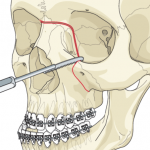Can A LeFort II Osteotomy Be Reversed?
Q: Dr. Eppley, I had a rhinoplasty combined with orbital and maxillary osteotomies on me. I am wondering if it is possible to completely or partially reverse the osteotomies specially the orbital ones. In my picture you see how there is a bone that sort of curves from the eyebrow to the eye corner and then from the eye corner to under the eye and then becomes the nasal sidewall? This bone is missing now. The entire nose is thinner at the dorsum and base of the pyramid and the bone between my eyes is thinner too. The operative report says he performed medial and lateral osteotomies. I don’t like how my sidewalks are gone… Is there a way to make my bones back to how they used to be? My nose is flat on the sides and has a very thin dorsum I had to add filler to make normal-looking. I liked my wide sidewalls before the surgery. The best way I can explain this is that the ascending process of the maxilla used to be very far apart from each other and now it’s all closer to the midline.
 A: What you had done was a LeFort II osteotomy. Bringing the nasomaxillary complex forward, it could be predicted that the nasal sidewalls would get more narrow. This is due to not only the bony area moving forward (telescoping effect) but the probable collapse of this thin bone area from the destabilizating effect of the osteotomies.
A: What you had done was a LeFort II osteotomy. Bringing the nasomaxillary complex forward, it could be predicted that the nasal sidewalls would get more narrow. This is due to not only the bony area moving forward (telescoping effect) but the probable collapse of this thin bone area from the destabilizating effect of the osteotomies.
To rebuilt this area, there are multiple options depending upon the type of graft to be used and the surgical approach. The simplest approach would be using injectable fat with the disadvantage of the high unpredictability of its survival. I would only do this if one was seeking a ‘non-surgical approach. Another semi-injectable approach would be the placement of hydroxyapatite cement placed through intranasal incisions. (similar to how nasal osteotomies are done) More traditionally, the bone grafts can be inserted through either an intranasal, eyelid or coronal approach. I assume that your LeFort II procedure was done through a combined intraoral and coronal incisions.
Dr. Barry Eppley
Indianapolis, Indiana

North Meridian Medical Building
Address:
12188-A North Meridian St.
Suite 310
Carmel, IN 46032
Contact Us:
Phone: (317) 706-4444
WhatsApp: (317) 941-8237
